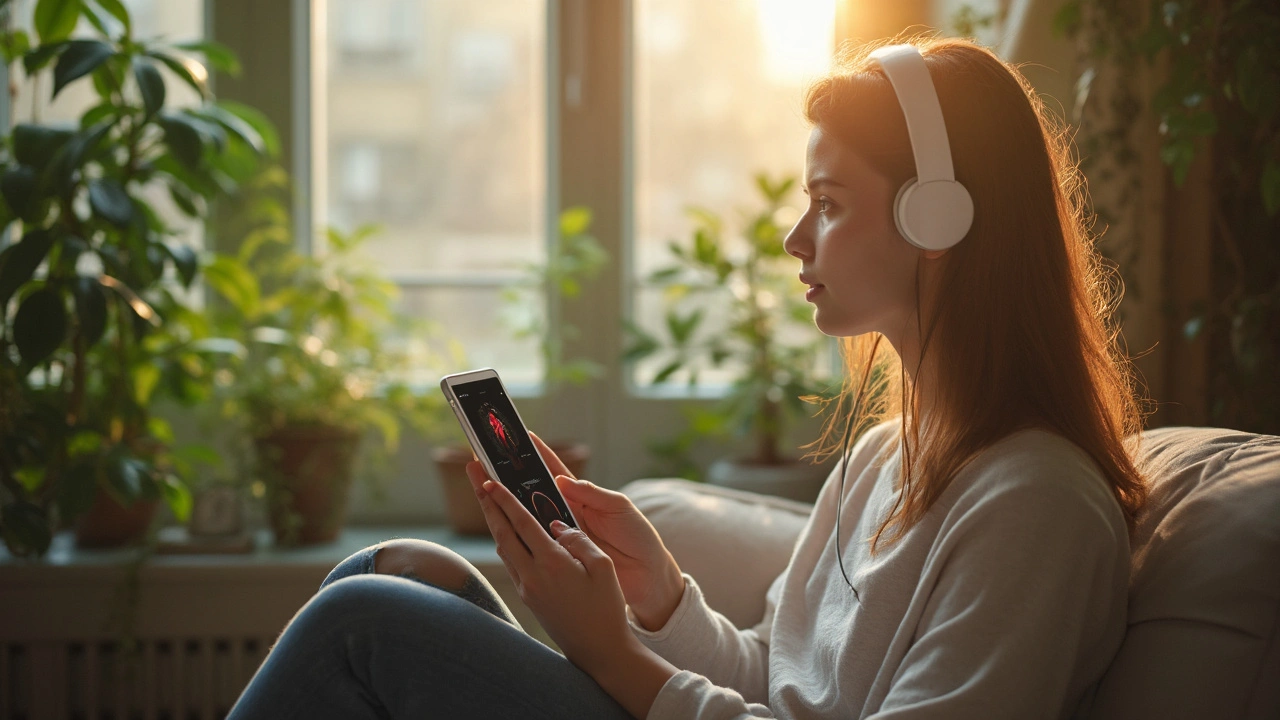Most people think mindfulness means sitting still and trying not to think about grocery lists. But what if you could get proof that you’re actually getting calmer? That’s where biofeedback steps in. It’s this clever way of using real-time body info—like your heart rate, your breathing, even how sweaty your palms get—to see what’s going on under your skin.
No guessing if your breathing is deep enough or your mind is wandering off. Imagine having a tiny coach that shows you exactly when you're tense and when you're chill, right on your phone or watch. That’s biofeedback. Suddenly, mindfulness isn’t just a mental game; it’s something you can see and tweak as you go. People using it say headaches get easier, sleep improves, even focus at work sharpens up. Sounds better than crossing your fingers and hoping for the best, right?
- What Is Biofeedback, Really?
- How Your Body Talks: Signals You Can Track
- From Science Lab to Living Room: Tools You Can Use
- Making Biofeedback Part of Mindfulness Practice
- Everyday Wins: Real-Life Stories
- Tips for Getting Started and Sticking With It
What Is Biofeedback, Really?
Biofeedback is basically a way for you to see what’s happening inside your body in real time. It’s not magic or guesswork—it’s science. When you’re nervous, your heart races and your breathing changes, right? Biofeedback lets you track those changes with simple sensors, so you pick up on stress faster and learn to chill out before things get out of hand.
Here’s how it works: special sensors stick to your skin, usually on your fingers, head, or chest. These sensors measure things like heart rate, breathing speed, skin temperature, and even tiny muscle movements. A small computer or app turns these signals into numbers or graphs you can actually read.
The goal with biofeedback isn’t just tracking what’s going on. It’s about using that info to teach your body how to respond better. You practice deep breathing, relax your muscles, or focus your mind, and the sensors give you instant feedback. That way, you know if what you’re doing is helping or if you need to try something else.
- This isn’t some new-age thing—biofeedback’s roots go back to the 1960s, and hospitals have used it for decades to help with migraines, high blood pressure, and anxiety.
- Tons of people use consumer biofeedback gadgets these days to cut stress, sleep better, and focus at work.
- Harvard researchers found that regular biofeedback use can reduce anxiety levels by up to 40% in people who stick with it for a few months.
Want to see just how common biofeedback devices track your body? Check out the stats below:
| Signal Tracked | What It Tells You | Popular Device Example |
|---|---|---|
| Heart Rate | Stress level, calmness | Fitbit, Apple Watch |
| Skin Conductance | Nervousness, excitement | Muse, StressEraser |
| Breathing Rate | Relaxation, tension | Spire, Oura Ring |
| Muscle Tension | Jaw clenching, anxiety | EMG Headbands |
With biofeedback, you don’t just “try to relax” and hope for the best. You get real proof—in numbers or colors—so you know if your body is truly winding down or just pretending to. That’s why it’s gotten so popular with folks who want practical results, fast.
How Your Body Talks: Signals You Can Track
Your body is always sending signals—even when you're just sitting in your chair, scrolling. Tiny, invisible things are happening, and biofeedback tools let you catch these in action. Let’s break down what you can actually measure to see the real story behind your everyday stress, focus, and feelings.
The most common signals people track with biofeedback are:
- Heart Rate: Most smartwatches do this already. A high heart rate might mean you’re anxious or tense, while steadier, slower beats usually show you’re relaxed.
- Heart Rate Variability (HRV): This is about how much your heartbeat speeds up and slows down with each breath. Higher HRV is linked to better stress resilience. Think of it as your body’s flexibility meter.
- Breathing Rate: Fast, shallow breaths tend to pop up when you’re worried or distracted. Slow, even breathing signals a calm, focused state. Some phone apps even let you watch your breath in real time.
- Skin Conductance: This measures how sweaty your palms get. Sweat glands fire up when you’re nervous, even if you don’t notice. It’s a solid clue for both stress and excitement.
- Muscle Tension: Tense shoulders? Jaw clenched? Sensors can pick that up before you do, which is super handy to stop headaches or catch stress habits early.
- Skin Temperature: Your hands might get colder when you’re anxious, because blood flow shifts. Warming up your hands (literally) is one way to know you’re relaxing.
Here’s a quick look at what these body signs mean and what they can tell you:
| Signal Type | What It Shows | Normal Relaxed Range |
|---|---|---|
| Heart Rate | Stress, excitement, calm | 60–80 bpm (resting adult) |
| Heart Rate Variability | Body's adaptability, stress response | >50ms difference (higher is better) |
| Breathing Rate | Anxiety, relaxation | 8–12 breaths/minute (resting) |
| Skin Conductance | Emotional arousal, stress | Low and stable (varies per person) |
| Muscle Tension | Physical stress, posture | Low baseline (measured by EMG) |
| Skin Temperature | Circulation, stress level | >90°F (palm temp, relaxed) |
Fun fact: HRV is the signal most linked to mental well-being and stress. Olympic athletes and even NASA astronauts use it to track how ready they are to focus—or wind down.
You don’t need to be a scientist to get the hang of any of these. Just paying attention to one or two signals can reveal so much. Next time your smartwatch or app pings you about your stats, take a second to look. It’s your body’s way of giving you feedback before you even notice anything’s up.
From Science Lab to Living Room: Tools You Can Use
When biofeedback first showed up, it was all hooked up to big machines behind closed doors in research labs. Fast forward to today, and you can work on biofeedback with gadgets no bigger than a deck of cards—or just your phone. You don’t have to be a scientist to use this stuff anymore. The tech has come straight into our homes, making it super simple for anyone to train their brain and body together.
The most common tools track heart rate, skin temperature, muscle tension, and breathing. Take heart rate variability monitors, for example. They let you see, in real time, whether your heart skips around when you’re stressed or settles into a nice rhythm as you relax. All you do is strap on a sensor or place your finger on your phone camera. You’ve probably heard of finger sensors or those wearable rings and watches. These are all real, accessible options you can buy online.
Here’s a quick look at some popular biofeedback tools and what they measure:
| Tool | What It Measures | Typical Use |
|---|---|---|
| HeartMath Inner Balance | Heart Rate Variability | Stress management, focus |
| Muse Headband | Brainwaves (EEG) | Meditation, relaxation |
| Garmin Vivosmart | Heart rate, respiration | General wellness, daily stress tracking |
| emWave2 | Heart Rate Variability | Feedback during breathing |
| GSR2 Sensor | Skin Conductance | Detecting tension, calming down |
More folks are using these at home now. According to a 2024 consumer health survey, about 1 in 6 adults in the US have used a wearable biofeedback device for stress or mindfulness in the past year.
Easy isn’t the same as instant, though. You’ll get more out of these gadgets if you use them with intention. Stick to simple steps:
- Pick a device that fits what you want to track, like heart rate or breathing.
- Follow the app or device instructions to set it up, which usually takes just a few minutes.
- Try a session daily, even if it’s just 5–10 minutes, to see patterns in your body’s stress levels.
- Use the feedback to practice changing your breathing or relaxing your muscles in real time.
Research backs up the benefits. Dr. Richard Gevirtz, Professor of Psychology at Alliant International University, says,
“Biofeedback is about giving people control over something that has always felt totally automatic. If you can see what’s happening inside, you can change it.”
If you want more features—like sleep tracking or integrated meditation instructions—look for devices with companion apps. And don’t stress about cost; prices now range from $60 for simple gadgets to around $250 for high-end headbands. You’ve got options, whether you want to keep it basic or geek out.

Making Biofeedback Part of Mindfulness Practice
Want to turn those numbers and graphs from your biofeedback device into something that actually helps your mood? Here’s the trick: make biofeedback part of your everyday mindfulness routine, not just another gadget to charge at night.
Start by picking one signal to track—heart rate is usually the easiest for beginners. Most smartwatches and some phone apps can do this right through your skin. Once you know your numbers, try these steps:
- Set aside five minutes where you won’t be interrupted.
- As you sit, watch your biofeedback screen. Pay attention to how your breathing, thoughts, or even annoying noises affect your stats.
- Take slow, deep breaths. Notice what happens to your heart rate or skin temperature. Does the number drop, even by just one or two beats? That’s real-time proof you’re actually relaxing.
- If you feel your mind wander or your numbers spike, take a second to reset. That’s normal. The whole point is to notice, not judge.
This isn’t just for anxiety or stress. Even Olympic athletes use biofeedback to boost focus and get out of their own heads when nerves hit. Research from Stanford found that people adding biofeedback to mindfulness saw anxiety levels drop by up to 40% in eight weeks.
| Biofeedback Signal | Mindfulness Impact |
|---|---|
| Heart Rate | Shows stress, calms with slow breathing |
| Skin Temperature | Often rises as you relax |
| Muscle Tension | Drops with mindful attention |
| Electrodermal Activity | High during stress, falls when calm |
The big win? You start to notice patterns. Maybe you tense up every time you check work email, or maybe your breath gets shallow before meetings. Once you see it, you can change it. Mindfulness goes from a buzzword to something you can actually measure—and improve—each day.
Everyday Wins: Real-Life Stories
People using biofeedback don’t have to take anyone’s word for it—they see the difference in their everyday lives. Take Jamie, for example. She used to get migraines twice a week. After trying a biofeedback app that tracks muscle tension in her forehead and breathing rate, her migraines dropped by half within two months. Her doctor noted the change, too, calling it better than any pill she’d tried before.
Then there’s Alex, a high school teacher who was constantly anxious in the classroom. With a simple heart rate monitor, he figured out his stress spikes before tough parent meetings. He started spending just five minutes before school with a biofeedback-guided breathing routine. Now he rarely goes into those meetings feeling on edge.
Kids are getting in on it, too. A small study from Stanford in 2023 looked at students with ADHD using wearable biofeedback for four weeks. The group using biofeedback tools got better focus scores by 23% compared to kids who used only mindfulness meditation without tech. They even had fewer calls home from frustrated teachers.
Biofeedback isn’t just for big issues. Rachel, a freelance designer, found her smartwatch’s biofeedback features helped her spot tense shoulders and headaches before deadlines. She hit a quick breathing exercise right when tension started, instead of realizing too late when the headache ruined her day.
| Person | Reason for Using Biofeedback | Result After 2 Months |
|---|---|---|
| Jamie | Frequent Migraines | 50% fewer migraines |
| Alex | Work Anxiety | Feels calm before meetings |
| Stanford Students | ADHD and Focus | 23% improvement in focus |
| Rachel | Work Stress | Stops headaches early |
It doesn’t always take expensive gear or hours of training to see these results. For most people, just linking a simple app or wearable with their mindfulness habit makes a noticeable change. If you’re tired of vague promises about stress relief, biofeedback lets you see and feel the proof in real time.
Tips for Getting Started and Sticking With It
If you’re thinking about using biofeedback for mindfulness, it’s way less complicated than it sounds. But setting up good habits from the start can make all the difference. Here’s how to make it work in real life instead of letting another gadget collect dust on your nightstand.
First, pick a simple biofeedback device or app. Heart rate sensors and breathing monitors are the most user-friendly. Look for ones that show instant data so you can see changes as you practice. The Muse headband and Inner Balance app from HeartMath are great starters, and both give clear, straightforward feedback you’ll actually understand.
- Start small: Spend just 5-10 minutes a day with your device. Consistency matters more than cramming in a big chunk on weekends.
- Track your progress: Many apps graph your improvements. Use this as motivation—the numbers don’t lie.
- Stick to a routine: Set an alarm as a reminder. Attach it to something you do every day, like right after brushing your teeth.
- Celebrate tiny wins: Notice when your resting heart rate drops or you’re feeling less tense after practice. Give yourself credit. This stuff is measurable and real.
If you want proof that it works, here’s a quick table with numbers from published clinical trials showing what beginners can expect after a few weeks of biofeedback training:
| Session Length | Practice Frequency | Average Stress Reduction (%) | Improved Focus (%) | Lowered Anxiety Symptoms (%) |
|---|---|---|---|---|
| 10 minutes | 5 days/week | 38 | 29 | 26 |
| 20 minutes | 3 days/week | 31 | 21 | 19 |
If you get stuck or bored, switch it up. Try different exercises or new tech. There are plenty of online communities for people using biofeedback—Reddit has a lively group, and HeartMath hosts live sessions.
Finally, remember that falling off the wagon is normal. Missed a few days? No drama—just start again the next day. That’s mindfulness in action, honestly. You’re learning, adjusting, and moving forward. That’s what counts.





